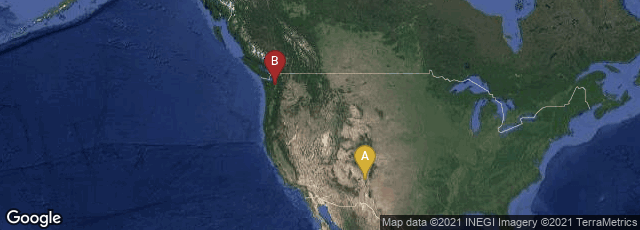
A: Albuquerque, New Mexico, United States, B: Seattle, Washington, United States
In Seattle, Washington, from 1973-74 high school students Bill Gates and Paul Allen, and Paul Gilbert founded a partnership called Traf-O-Data. The objective was to read the raw data from roadway traffic counters and create reports for traffic engineers. Even though this initial project was not a success, the experience that Gates and Allen gained in writing software for a non-existent computer they applied shortly thereafter in writing software for the MITS Altair.
"Bill Gates and Paul Allen were high school students at Lakeside School in Seattle. The Lakeside Programmers Group got free computer time on various computers in exchange for writing computer programs. Gates and Allen thought they could process the traffic data cheaper and faster than the local companies. They recruited classmates to manually read the hole-patterns in the paper tape and transcribe the data onto computer cards. Gates then used a computer at the University of Washington to produce the traffic flow charts. (Paul Allen's father was a librarian at UW.) This was the beginning of Traf-O-Data.
"The next step was to build a device to read the traffic tapes directly and eliminate the tedious manual work. The Intel 8008 microprocessor was announced in 1972 and they realized it could read the tapes and process the data. Allen had graduated and was enrolled at Washington State University. Since neither Gates nor Allen had any hardware design experience they were initially stumped. The computer community in Seattle at that time was relatively small. Gates and Allen had a friend, Paul Wennberg who like them had hung around CDC Corporation near the University of Washington cadging open time on the mainframe. Wennberg, founder of the Triakis Corporation, was then an electrical engineering student at the University of Washington. In the course of events Gates and Allen mentioned they were looking for somebody to build them a computer for free. They needed somebody good enough to build a computer from parts and the diagrams found in a computer magazine. It was Wennberg who came up with the man to do just that. After discussion with another friend, Wes Prichard, Prichard suggested to Wennberg that Gates and Allen head over UW Physics building to where Gilbert, another EE student worked in the high-energy tracking lab. It was there that Paul Gilbert was approached by the duo to become a partner in Traf-O-Data. That year Gilbert, piece by piece, wire wrapped, soldered and, assembled from electrical components the (world's first?) working microcomputer. Miles Gilbert, Paul Gilbert's brother, a graphic designer and draftsman, helped the fledgling company by designing the company's logo. Gates and Allen started writing the software. To test the software while the computer was being designed, Paul Allen wrote a computer program on WSU's IBM 360 that would emulate the 8008 microprocessor.
"The computer system was completed and Traf-O-Data produced a few thousand dollars of revenue. Later the State of Washington offered free traffic processing services to cities, ending the need for private contractors, and all three principals moved on to other projects. The real contribution of Traf-O-Data was the experience that Gates and Allen gained developing software for computer hardware that did not exist. Paul Gilbert, sometimes referred to as "the hardware guy", was the man who made Traf-O-Data work. Without his efforts in the construction of this computer, and the day-to-day running of this pioneering company, the rise of what became Microsoft might have been delayed" (Wikipedia article on Traf-O-Data, accessed 07-13-2011).
On April 4, 1975 Bill Gates and Paul Allen officially founded Micro-Soft (Microsoft) in Albuquerque, New Mexico, with Gates as CEO. Allen invented the original company name, "Micro-Soft." The initial purpose of the company was to develop an implementation of the programming language BASIC for the MITS Altair personal computer. Revenues of the company totaled $16,005 by the end of 1976.
"Within a year, the hyphen was dropped, and on November 26, 1976, the trade name "Microsoft" was registered with the Office of the Secretary of the State of New Mexico." (Wikipedia article on Bill Gates, accessed 07-13-2011).
Early in 1975 Gates, Allen, and Monte Davidoff wrote a version of the Basic programming language that ran on the MITS Altair 8800.
"After reading the January 1975 issue of Popular Electronics that demonstrated the Altair 8800, Gates contacted Micro Instrumentation and Telemetry Systems (MITS), the creators of the new microcomputer, to inform them that he and others were working on a BASIC interpreter for the platform. In reality, Gates and Allen did not have an Altair and had not written code for it; they merely wanted to gauge MITS's interest. MITS president Ed Roberts agreed to meet them for a demo, and over the course of a few weeks they developed an Altair emulator that ran on a minicomputer, and then the BASIC interpreter. The demonstration, held at MITS's offices in Albuquerque, was a success and resulted in a deal with MITS to distribute the interpreter as Altair BASIC." (Wikipedia article on Bill Gates, accessed 07-13-2011).
Called Altair Basic, or in its first iteration, MITS 4K Basic, the program was written without access to an Altair computer or even an 8080 CPU. Altair Basic was the first computer language written for a personal computer, and the first product of "Micro-Soft," which in 1976 was renamed Microsoft.
On February 3, 1976 Gates, in his role as "General Partner Micro-Soft", Albuquerque, New Mexico, wrote An Open Letter to Hobbyists, making the distinction between proprietary and open-source software.
Gates's one page letter was first pubished in Computer Notes, 1, #9 (February 1976). Computer Notes was the house journal of MITS, the company that developed the MITS Altair 8800 and licensed Micro-Soft's version of BASIC.
My thanks to Chris Morgan for drawing my attention to Gates and Allen's early experience with Traf-O-Data.